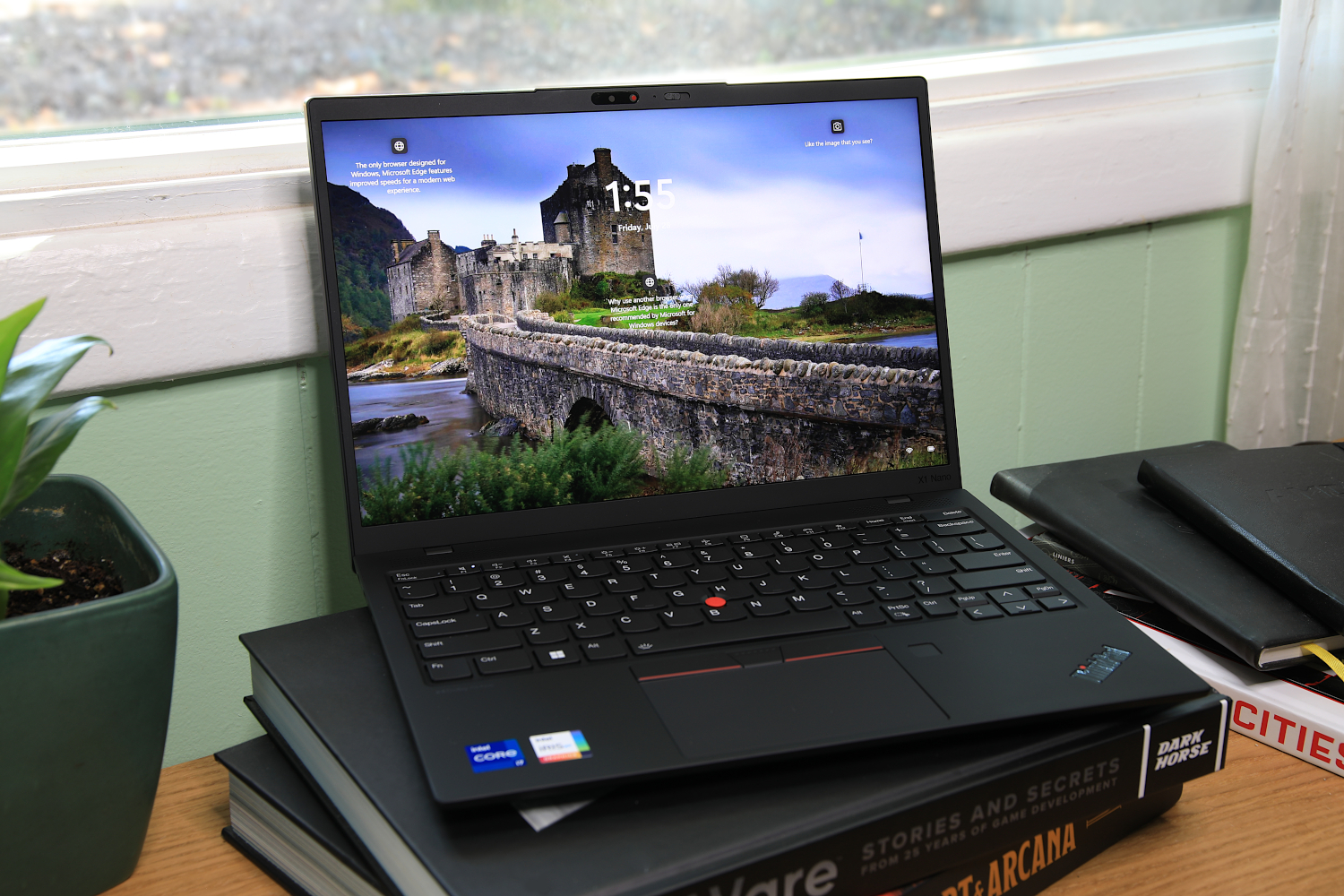 At a glance
At a glanceExpert's Rating
Pros
- The CPU performance is suitable for a range of productivity tasks
- It has a long battery life
- Connectivity includes two Thunderbolt 4 ports
Cons
- The display could be a little brighter still
- The function keys are quite small
- Intel Iris Xe graphics only
Our Verdict
The Asus Zenbook 14 Flip OLED is an exceptionally fine laptop for proactive business professionals needing a lightweight OLED 2-in-1 with all the connectivity mod cons and an all-day battery life.
Best Prices Today: Asus Zenbook 14 Flip OLED
Ultrabooks carry the burden of having to be ultra-light and ultra-thin while still providing the kind of experience that will have users singing their praises. While manufacturers often make big claims about their capabilities, in most, obvious limitations tend to appear after a while. Not so the Asus Zenbook 14 Flip OLED which executes its role as a dependable, but powerful Ultrabook to near perfection. This is a laptop that seemingly has it all – a zippy high-end CPU, versatile convertible design, long battery life and all the mod cons of connectivity that busy professionals need.
With a stunning 2.8K OLED display and starter price of $999, Asus’s newest 14-inch convertible, is also affordable enough to redefine the OLED laptop experience, moving it from the realm of the wealthy enthusiast to everyone and anyone lucky enough to pick one up. Read on to find out more.
Looking for more options? Check out PCWorld’s roundup of the best laptops available today.
Asus Zenbook 14 Flip OLED: Specifications
The Asus Zenbook 14 Flip OLED comes in two CPU configurations, either an Intel i5-1340P model or Intel i7-1360P model. Both come with a 2.8K OLED display and 16GB DDR5 RAM as standard. The base model with i5 comes with 512GB of storage and costs $999, while the i7 model doubles the storage capacity to 1TB for an extra $201 at the checkout.
Sizing up this offering against other Ultrabooks in the market and just based on its specs the 14 Flip OLED is very reasonably priced. For example, PCWorld recently reviewed the 13-inch Lenovo ThinkPad X1 Nano which sports a i7-1360P CPU and a more basic 1080p display, which at the time of writing cost $1,714. Although, it should be noted, Lenovo now has an “available soon” label on this laptop on its website, and the current price is unknown. The exact specifications of our review unit are as follows:
- CPU: Intel Core i7-1360P
- RAM: 16GB / 4800 MHz
- Graphics: Intel Iris Xe
- Display: 14-inch, 16:10 aspect ratio, 2.8K (2880 x 1800p) resolution, OLED panel, touch-sensitive, 90Hz refresh rate, 0.2ms response time, 100 % DCI-P3 color gamut, VESA certification
- Storage: 1TB PCIe Gen4 SSD
- Webcam: 1080p
- Connectivity: 2 x Thunderbolt 4, USB-A 3.2 Gen 2, HDMI 2.1, 3.5 mm combo audio jack
- Networking: Wi-Fi 6E (802.11ax), Bluetooth 5.3
- Battery capacity: 75WHrs
- Dimensions: 12.26 x 8.80 x 0.63 inches
- Weight: 3.31lbs (1.50 kg)
- Cost: Starts at $999 ($1199.99 this configuration)
Asus Zenbook 14 Flip OLED: Design
As one of the 2-in-1 convertible models of Asus’s Zenbook line-up, this laptop is designed to be picked up and folded through 360 degrees. That being the case, at 3.31 pounds its reasonably lightweight. It’s also quite thin, measuring just 0.63 inches through the chassis. That’s not to say it’s the thinnest Ultrabook you will find – options like the Lenovo ThinkPad X1 Nano and Apple MacBook Air M2 have its measure here – but on the upside, it does feel a little more robust than these Ultrabooks.
The sturdiness is most noticeable around the base of the chassis – I wasn’t able to get it to flex or squeak by applying firm pressure, so you could easily pile luggage on top of it in a travel situation and know it’ll stand up to the weight. The ErgoLift hinges are large and feel powerful too. They hold the display at any angle you may wish to place it – save half an inch from closed. This tautness means it’s a safe bet for using in tent mode.
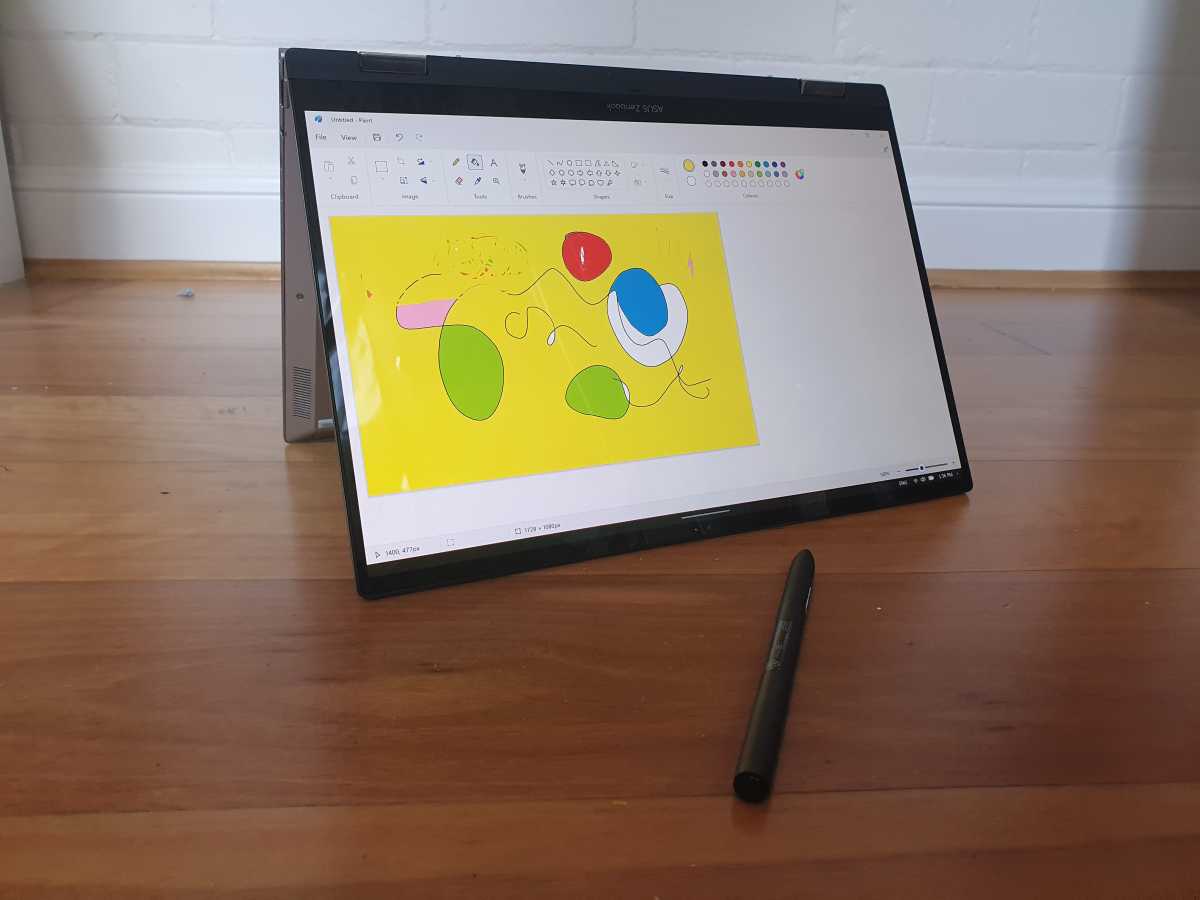
Dominic Bayley / IDG
Being just 14 inches in size, the 14 Flip OLED is also extremely compact – although you’d be excused for thinking it’s a lot bigger when the lid’s flipped open. That’s mostly because of the 16:10 aspect ratio, which extends the vertical viewing space more than the ageing 16:9 panel format. In fact, with ultra-thin NanoEdge bezels and an impressive 87 percent screen-to-body ratio, there’s ample panel space for comparing multiple browser windows or spreadsheets.
Silver is a common color in productivity laptops, but not the Foggy Silver shown off here. It feels a little more rock ‘n’ roll, so you don’t get as many of those working vibes when you kick back and watch videos at home. The laptop’s sandblasted finish also has a nice tactile feel. I also liked the thin geometric lines on the lid, which do a nice job breaking up the uniform grey; they relax the laptop’s look even further.
Asus Zenbook 14 Flip OLED: Ports and connectivity
It may be only as thick as a chopping board, but Asus has still managed to pack in a decent selection of ports for your various input/output needs. There are only three USB ports on offer, one USB-A 3.2 Gen2 port as well as two Thunderbolt 4 ports, but it’s a combination that will nicely accommodate a mouse, keyboard and another useful device like a USB hub.
A HDMI 2.0 port and 3.5 mm combo jack round out the port selection – all-in-all making for a very aggressive productivity-focused offering.
“You can access a light-up numpad via the laptop’s ErgoSense trackpad. The trackpad also supports multi-touch gestures in Windows, which is a great timesaver…
The addition of the Thunderbolt 4 ports means this laptop is well prepared for the demands of mobile or hybrid work. While these ports still use the USB-C connector type, a big benefit is they give you access to three protocols – USB 4, DisplayPort 1.4 and PCIe 4 in a single port. They also provide quicker 40Gbs data transfer speeds. And, just one of these can stream 4K content to two external displays.
Indeed, if you’re a photographer needing to download files larger than 100 megapixels from a drone or DSLR camera, or a videographer, architect, or director working with a 3D program like CAD, this is exactly the kind of port type you’ll want.
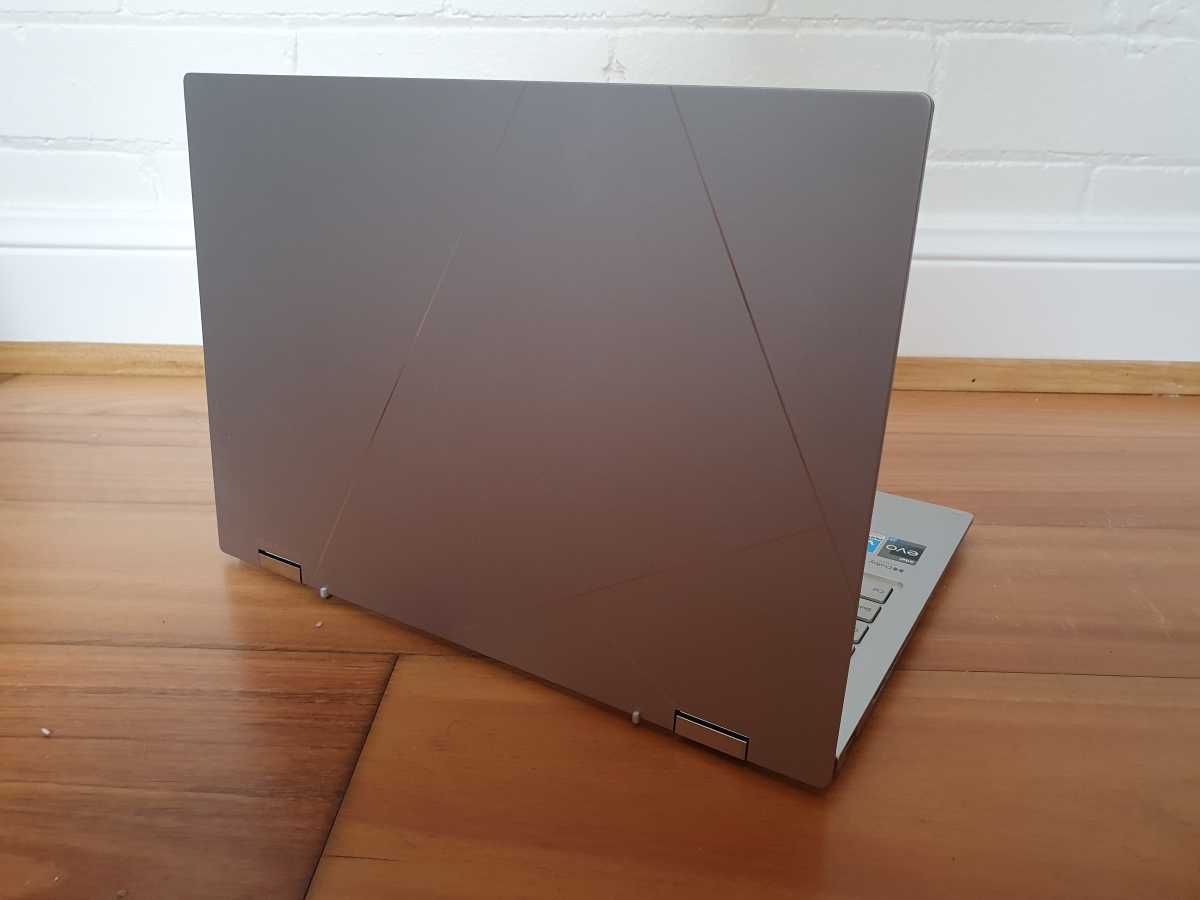
Dominic Bayley / IDG
Loading webpages and videos was also a very quick affair on the 14 Flip OLED thanks to its Wi-Fi 6E connectivity, which is the latest standard on offer. Wi-Fi 6E adds support for the 6GHz wi-fi spectrum and provides faster wi-fi speeds. It also boasts lower latencies than the previous best standard Wi-Fi 6. Suffice to say, you’ll likely find it a real productivity booster if you’re currently using an older laptop and do a lot of browsing.
Asus Zenbook 14 Flip OLED: Keyboard and trackpad
Typing on the 14 Flip OLED’s keyboard was very comfortable, each of the keys feeling remarkably responsive. They have a generous 1.4 mm travel, but more importantly, they feel nice and springy thanks to rubber dome cushioning that meets your fingers with just the right amount of upward force.
In a nutshell, that meant I could type very lightly without becoming fatigued or getting sore fingertips or phalanges. I could also reach quick typing speeds with a noticeable reduction in the number of mistakes I normally make. The keys also feature chiclet backlighting so they’re easily visible at night.
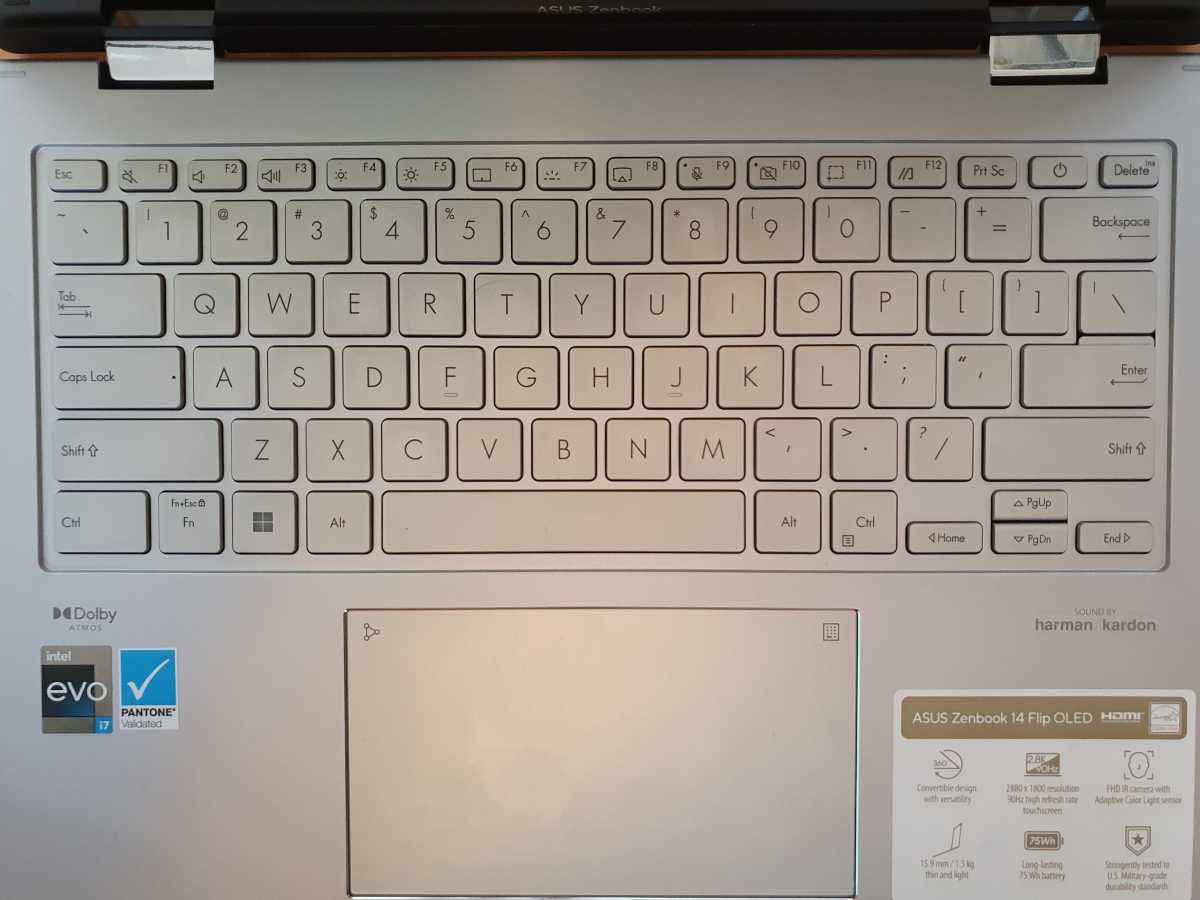
Dominic Bayley / IDG
Overall, the layout feels nicely balanced. Being a small laptop, you get a mostly basic key selection. The arrow keys are a little longer horizontally than in some productivity laptops, which made flicking through figures in spreadsheets a little faster. Unfortunately, the same can’t be said for the function keys, which are quite small and feel a bit cramped.
Unlike its larger stablemate the Asus Zenbook 15 OLED, this laptop doesn’t have a dedicated numpad – rather you can access a light-up numpad via the laptop’s ErgoSense trackpad. The trackpad also supports multi-touch gestures in Windows, which is a great timesaver worth using. The trackpad also has a PVD anti-fingerprint coating, so it feels silky smooth and won’t easily hold unsightly marks.
Asus Zenbook 14 Flip OLED: Display and audio
My review unit’s OLED display has a resolution of 2880 x 1800p which carries the moniker 2.8K. Asus claims the display covers 100 percent DCI-P3 color gamut and has 550 nits peak brightness rating. It also boasts Pantone certification.
Looking at the quality, and there was a high level of detail in images. The colors were remarkably bright and saturated too. Indeed, comparing colors on the OLED against pantone sample printouts, I can confidently say the hues were almost indistinguishable.
The contrast was equally impressive despite me only being able to register a peak brightness of 335 nits with my Lux meter. That may have been due to the protective Corning Gorilla Glass covering the panel, which for the sake of the display’s build quality, I was really happy Asus included. Nonetheless, the blacks appeared remarkably deep, which made darker images really standout.
Comparing video against that on my regular work laptop’s 1080p 60 Hz IPS-level display and not only did it look much more detailed, but it was also eminently smoother thanks to a higher 90 Hz refresh rate. Combined with the quick wi-fi, this made watching news blasts and browser-based videos a really seamless experience.
Touch functionality has really come of age in Asus’s panels judging also by how quickly the panel responded to my finger presses. The laptop also comes with Asus’s next generation stylus, the Asus Pen 2.0. This stylus has numerous advantages over the previous generation, including a greater touch sensitivity (4096 versus 1024) and a wider range of tip force (5-350 g versus 10-300 g).
Basically, that means you get a finer distinction in the thickness of the lines you draw, which ultimately results in your drawings looking more like real pen to paper ones. Mucking about with the stylus in Windows Paint, I really noticed a marked improvement in the linearity from other styluses I’ve tried out, especially in diagonal and curved lines which appeared unjagged, even when zooming in to inspect them.
Asus Zenbook 14 Flip OLED: Audio and webcam
For audio, the 14 Flip OLED has two Harman Kardon-certified speakers. Generally speaking, I often find the sound quality in ultra-light 14-inch laptops to be a little tinny, but these speakers mustered a surprisingly clear and vibrant sound. However, their downwards-facing location beneath the front sides of the chassis meant I did lose some clarity by the time the sound reached my ears.
The 14 Flip OLED comes with a 1080p camera with infrared functionality to support a hands-free biometric login via Windows Hello. It’s perfectly suitable for meetings and conferencing in different environmental conditions, since the AI uses an ambient light color sensor that adjusts the light and color temperature to mostly keep your face looking naturally lit and without distorting any details. The noise cancellation algorithm also does a decent job blocking unwanted background noise, so your meetings won’t be disturbed by the often-noisy machinations of work or home life.
Asus Zenbook 14 Flip OLED: Performance
The 14 Flip OLED’s Core i7-1360P processor is a high-end processor from Intel’s Raptor Lake-P family – especially made for ultra-light and thin laptops like this one. This chip features 12 cores (4 performance cores and 8 efficient cores) and boasts a 5GHz maximum turbo boost speed. For comparison’s sake, its performance has been compared to Intel’s Core i7-1270P (one of last year’s higher-end productivity chips), so it’s considered well prepared for even the most demanding of programs.
To test those claims I zeroed in on Maxon’s R20 Multi-Threaded benchmark. This CPU-specific benchmark flexes all the cores of a laptop’s CPU to give us an indication of how well it’s likely to fare when the same happens in a real scenario. I graphed the results below.

Dominic Bayley / IDG
In UL’s PCMark 10 benchmark, our laptop’s Core i7-1360P powered on through each of the productivity tasks to end up with a PCMark 10 overall score of 5623. Considering this benchmark flexes both the CPU and the laptop’s graphics hardware, you could say our laptop’s result is a solid effort for one that lacks a discrete GPU.
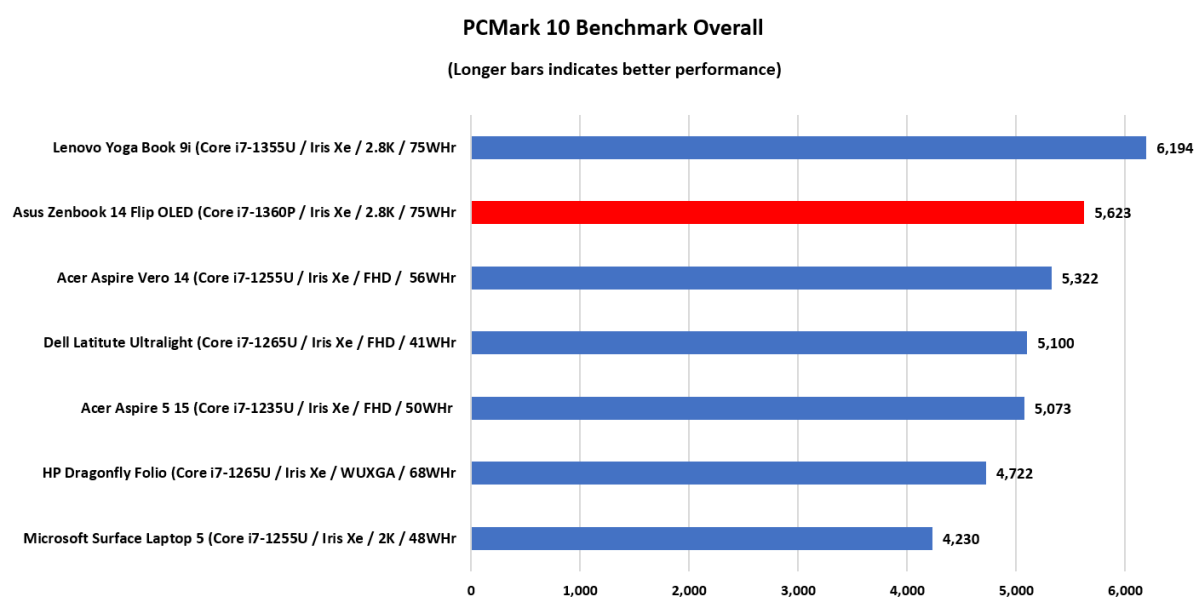
Dominic Bayley / IDG
Looking at graphics performance, and the 14 Flip OLED achieved a score of just 1,671. A score like that’s not unusual or unexpected for a laptop that relies purely on its Intel Iris Xe chip to produce graphics. This kind of performance is a far cry from the kind you’ll see in gaming and creator focused laptops with discrete GPUs – although they’re also mostly too thick and heavy to be classed as Ultrabooks.
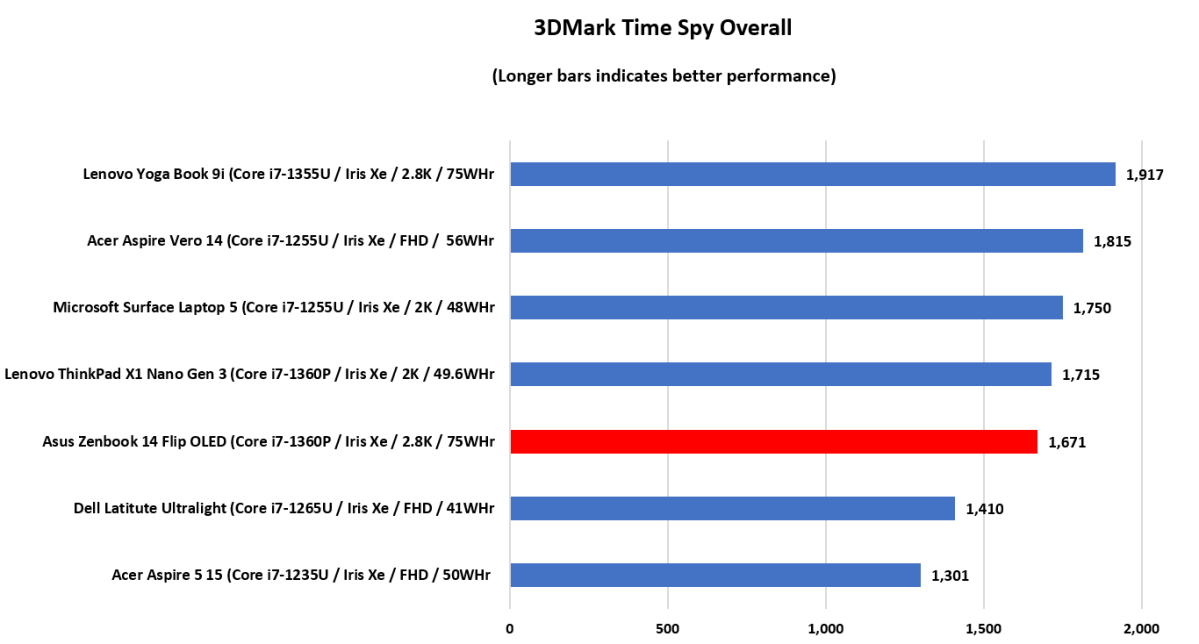
Dominic Bayley / IDG
In summary, these results tell us a favorable story about the 14 Flip OLED’s performance capabilities. They show us a laptop that can very easily power through productivity tasks like spreadsheeting, video conferencing and web browsing and just as easily run demanding programs in Microsoft Office or Adobe’s Creative Suite. Admittedly, they also show us that the 14 Flip OLED’s 3D graphics performance is just okay, meaning it’s a lot less powerful than laptops with discrete GPUs. Then again, lighter 3D graphics performance is entirely what Asus intended it for.
Besides, creators needing more grunt in the graphics department are well catered for in Asus’s 2023 lineup with options like the Asus14 Pro Duo OLED, which is thicker and heavier than our laptop, but also comes with a gorgeous 14-inch display. The 14 Flip OLED’s portability advantage is undoubtedly going to be the big drawcard here for most business professionals, who most likely won’t be doing much intensive 3D graphics work anyway.
Asus Zenbook 14 Flip OLED: Battery life
The 14 Flip OLED comes with a high capacity 75Whr battery and a very small compact 65-watt USB-C charger. Mobile and hybrid workers – heck even office workers – aren’t always near AC outlets. Ergo, a laptop like the 14 Flip OLED should ideally have enough battery life to run a whole eight hour working day and then some.
To find out if it does, I set a 4K movie on repeat in the Windows Film and TV app and switched the battery to airplane mode. I also set the volume to 50 percent and plugged in a cheap pair of headphones to deal with the sound. Then I sat back and timed how long it lasted until it ran out of juice.
As you can see in the graph below, the 14 Flip OLED’s battery conked out approximately 12 hours later. This is a decent length of time that should save you from unnecessary disruptions throughout your working day.
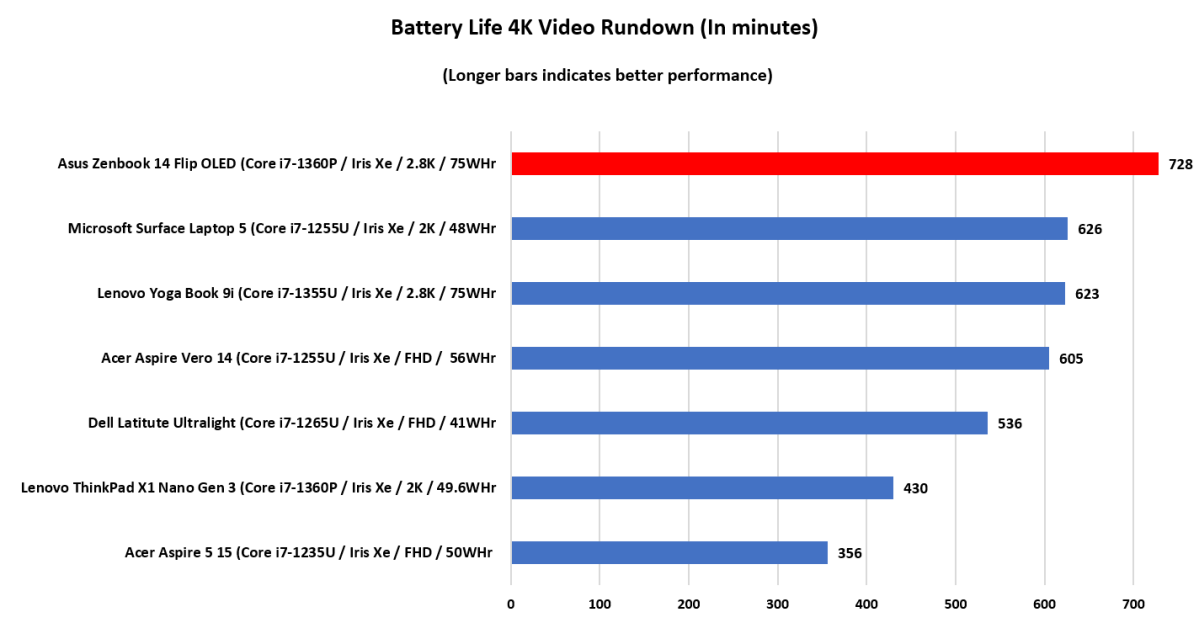
Dominic Bayley / IDG
Additionally, it’s reassuring to know you can easily top the battery up again in a jiffy. Asus claims the laptop’s USB-C fast charger provides up to 60 percent of full charge in as little as 49 minutes. You can also use any standard USB-C charger in the event you leave the official one at home, which is very convenient.
Should you buy the Asus Zenbook 14 Flip OLED?
The Asus Zenbook 14 Flip OLED is an exceptional option for business professionals wanting an attractive and dependable workhorse with all the mod cons. The 14 Flip OLED mostly has it all; it’s lightweight and ultra-thin, has excellent connectivity and all the versatility benefits of a convertible design. Plus, it sports a gorgeous OLED display, robust build and a battery life that will go all day. Without a discrete graphics card, it’s not quite the 3D graphics powerhouse many creators will need, but what it lacks in that department it more than makes up for in portability.


